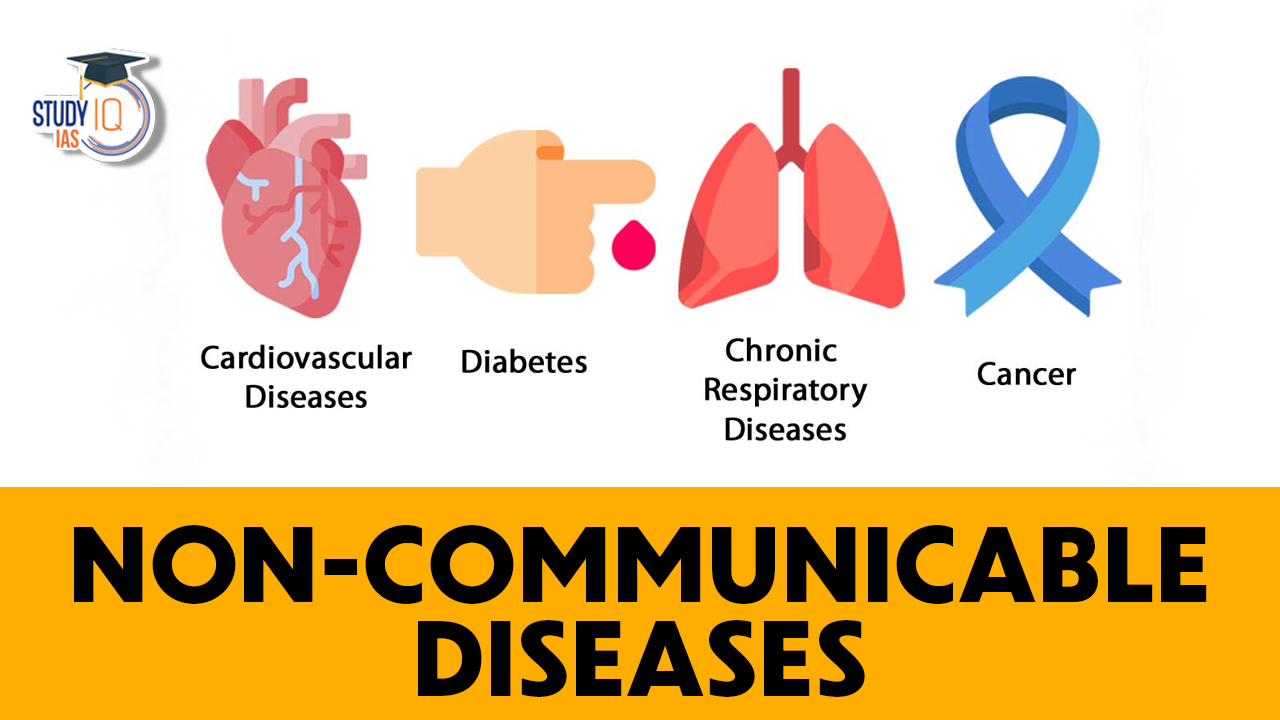Table of Contents
Context: A new study for diabetes and other non-communicable diseases (NCD) shows that 31 million more Indians became diabetic in four years (2019-2021).
Key highlights of the study
- The study was funded by the Indian Council of Medical Research (ICMR) and Department of Health Research, Ministry of Health and Family Welfare and co-ordinated by the Madras Diabetes Research Foundation.
- The decade-long nationwide study is the first comprehensive epidemiological research paper which includes participants from 31 States and some Union Territories.
- Key findings:
- In 2021, India has 101 million people with diabetes and 136 million people with prediabetes.
- Additionally, 315 million people had high blood pressure; 254 million had generalised obesity, and 351 million had abdominal obesity.
- 213 million people had hypercholesterolaemia (wherein fat collects in arteries and puts individuals at greater risk of heart attack and strokes) and 185 million had high low-density lipoprotein (LDL) cholesterol.
- Two big trend indicators in the study:
- Diabetes and other metabolic non-communicable diseases, such as hypertension, obesity and dyslipidemia are much more common than estimated previously in India.
- While currently urban regions had higher rates of all metabolic NCDs than rural areas, with the exception of prediabetes, rural India will see a diabetes explosion in the next five years if left unregulated.
- Inter-regional variations:
- The highest diabetes prevalence was found in Goa, Puducherry and Kerala.
- While prediabetes was prevalent in Sikkim, hypertension was highest in Punjab.
- Generalised obesity and abdominal obesity were highest in Puducherry, while Kerala had high hypercholesterolemia and high LDL cholesterol.
- The lowest prevalence of NCDs was found in U.P., Mizoram, Meghalaya and Jharkhand.
What are Non-Communicable Diseases (NCDs)?
- Non-communicable diseases are chronic diseases that tend to be of long duration and are the result of a combination of genetic, physiological, environmental, and behavioural factors.
- These diseases are not contagious and cannot be spread from person to person.
- The main types of NCDs include cardiovascular diseases (such as heart attacks and stroke), cancers, chronic respiratory diseases (such as chronic obstructive pulmonary disease and asthma), and diabetes.
Causes of Non-Communicable Diseases (NCDs)
- NCDs have multiple causes, including genetic, physiological, environmental, and behavioural factors.
- However, the rise of NCDs in recent years has been largely driven by certain risk factors, such as tobacco use, harmful use of alcohol, unhealthy diet, physical inactivity, overweight/obesity, raised blood pressure, raised blood sugar, and raised cholesterol.
- These risk factors are often linked to lifestyle choices and environmental factors.
- For example, tobacco use and harmful use of alcohol are behavioural risk factors that are closely linked to addiction and social factors.
- Unhealthy diet, physical inactivity, and overweight/obesity are also behavioural risk factors that can be influenced availability of healthy food options.
Consequences of Non-Communicable Diseases (NCDs)
- NCDs can lead to disability, reduced quality of life, and premature death.
- The socioeconomic costs associated with NCDs are also substantial and include direct costs related to healthcare, as well as indirect costs related to lost productivity and reduced economic growth.
- The disease kills 7 out of 10 people globally from risk factors like tobacco, alcohol, unhealthy diet, physical inactivity and air pollution.
- Apart from deaths, NCDs take a heavy toll on economies, cutting down people in their most productive years.
Global prevalence of NCDs
- Recently, the World Health Organisation (WHO) released its report “Invisible Numbers – The True Extent of Non-communicable Diseases and What to Do About Them”.
- Key highlights of the report include:
- The report stated that every two seconds, one person under the age of 70 dies of a NCD with 86% of those deaths occurring in low- and middle-income countries.
- NCDs are collectively responsible for almost 70% of all deaths worldwide, with almost three-quarters of all NCD deaths and 82% of premature deaths occurring in low- and middle-income countries.
- Globally, one in three deaths – 17.9 million a year – are due to cardiovascular diseases (CVDs).
- Two-thirds of the people with hypertension live in low- and middle-income countries, but almost half of the people with hypertension are not even aware they have it, it currently affects around 1.3 billion adults aged between 30 and 79.
Prevalence of NCDs in India
A report titled “India: Health of the Nation’s States” by the Indian Council of Medical Research (ICMR) observed that:
- The proportion of deaths due to NCDs has increased from 37.9% in 1990 to 61.8% in 2016.
- The leading causes of death due to NCDs in India are cardiovascular diseases, chronic respiratory diseases, cancer, and diabetes.
- NCDs are responsible for 55% of the total disability-adjusted life years (DALYs) in India, which is a measure of the overall disease burden.
- The burden of NCDs is higher in the more developed states of India compared to the less developed ones.
- Unhealthy lifestyle choices such as tobacco and alcohol use, unhealthy diets, and physical inactivity are the major risk factors for NCDs in India.
- The study highlights the need for preventive measures such as promoting healthy lifestyle choices and improving access to healthcare services.

Initiatives to deal with NCDs
Global Initiatives: Some of the global initiatives to deal with NCDs include:
- The Sustainable Development Goals (SDGs): The SDGs include a target to reduce premature mortality from NCDs by one-third by 2030 (SDG 3.4).
- WHO Global Action Plan for the Prevention and Control of NCDs 2013–2020: This action plan aims to reduce premature mortality from NCDs by 25% by 2025 and includes a set of nine global targets.
- WHO Framework Convention on Tobacco Control: This international treaty aims to reduce tobacco consumption and the related harm to health.
- United Nations High-Level Meeting on NCDs: This meeting, held in 2018, focused on accelerating progress on the prevention and control of NCDs and called for increased political commitment and action.
- The NCD Alliance: This is a global network of civil society organizations working to prevent and control NCDs. It advocates for policy change and increased investment in NCD prevention and management.
India’s Initiatives
- National Programme for Prevention and Control of Cancer, Diabetes, Cardiovascular Diseases and Stroke (NPCDCS) is being implemented under the National Health Mission.
- The programme focuses on strengthening infrastructure, human resource development, health promotion & awareness generation for prevention, early diagnosis, management and referral to an appropriate level of healthcare facility for treatment of the NCDs.
- Recently, the government has renamed this programme as National Programme for Prevention & Control of Non-Communicable Diseases (NP-NCD).
- The Central Government is implementing the Strengthening of Tertiary Care Cancer facilities scheme to support the setting up of State Cancer Institutes (SCI) and Tertiary Care Centres (TCCC) in different parts of the country.
- Fit India movement is being implemented by the Ministry of Youth Affairs and Sports, and various Yoga related activities are carried out by the Ministry of AYUSH.
- Preventive aspect of NCDs is strengthened under Comprehensive Primary Health Care through Ayushman Bharat Health Wellness Centre scheme, by promotion of wellness activities and targeted communication at the community level.
- Affordable Medicines and Reliable Implants for Treatment (AMRIT) Deendayal outlets have been opened at 159 Institutions/Hospitals with an objective to make available Cancer and Cardiovascular Diseases drugs and implants at discounted prices to the patients.
- Jan Aushadhi stores are set up by the Department of Pharmaceuticals to provide generic medicines at affordable prices.


 Daily Quiz 14 April 2025
Daily Quiz 14 April 2025
 UPSC Syllabus 2025, Check UPSC CSE Sylla...
UPSC Syllabus 2025, Check UPSC CSE Sylla...
 EU Plans to Slash General Data Protectio...
EU Plans to Slash General Data Protectio...





















